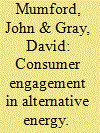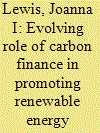|
|
|
Sort Order |
|
|
|
Items / Page
|
|
|
|
|
|
|
| Srl | Item |
| 1 |
ID:
096137


|
|
|
|
|
| Publication |
2010.
|
| Summary/Abstract |
Problem of high energy use for heating in Slovenian buildings is analyzed with exergy and energy analysis. Results of both are compared and discussed. Three cases of exterior building walls are located in three climatic zones in winter conditions. Results of energy analyses show that the highest heating energy demand appears in the case with less thermal insulation, especially in colder climate. If the comparison is made only on the energy supply and exergy supply, the results of exergy analysis are the same as those of energy analysis. The main difference appears, if the whole chain of supply and demand is taken into consideration. Exergy calculations enable us to analyze how much exergy is consumed in which part, from boiler to building envelope. They also reveal how much energy is supplied for the purpose of heating. Results show that insulation has much bigger effect than effect of boiler efficiency. However, the most effective solution is to improve building envelope together with boiler efficiency. Better thermal insulation also makes an important contribution to the improvement of thermal comfort conditions. It causes higher surface temperatures resulting in a larger warm radiant exergy emission rate and consequently better thermal comfort.
|
|
|
|
|
|
|
|
|
|
|
|
|
|
|
|
| 2 |
ID:
096142


|
|
|
|
|
| Publication |
2010.
|
| Summary/Abstract |
The greenhouse gas mitigation potential of different economic sectors in three world regions are estimated using a bottom-up approach. These estimates provide updates of the numbers reported in the Fourth Assessment Report of the Intergovernmental Panel on Climate Change (IPCC AR4). This study is part of a larger project aimed at comparing greenhouse gas mitigation potentials from bottom-up and top-down approaches. The sectors included in the analysis are energy supply, transport, industry and the residential and service sector. The mitigation potentials range from 11 to 15 GtCO2eq. This is 26-38% of the baseline in 2030 and 47-68% relative to the year 2000. Potential savings are estimated for different cost levels. The total potential at negative costs is estimated at 5-8% relative to the baseline, with the largest share in the residential and service sector and the highest reduction percentage for the transport and industry sectors. These (negative) costs include investment, operation and maintenance and fuel costs and revenues at moderate discount rates of 3-10%. At costs below 100 US$/tCO2, the largest potential reductions in absolute terms are estimated in the energy supply sector, while the transport sector has the lowest reduction potential.
|
|
|
|
|
|
|
|
|
|
|
|
|
|
|
|
| 3 |
ID:
096092


|
|
|
|
|
| Publication |
2010.
|
| Summary/Abstract |
This paper describes how management and information failures can retard transitions from the traditional use of biomass fuel by low income rural consumers and micro-producers.
In general, societies move away from traditional biomass use as economic development takes place. If one accepts the doctrine of revealed preference (built on the initial work of Samuelson, 1938), then these trends imply that such transitions provide net gains in utility. This paper shows how various "failures" entrench existing fuel use patterns-hindering the transition to new fuel use patterns.
In order to qualitatively discuss how these transitions may take place, an indicative neo-classical description of consumer and producer behavior is used. Three types fuel-transition "driver" are identified. The effect of information and management failures on these drivers, and thus the energy transition, is discussed.
Reference is made to a specific case study in which a partial transition from biomass occurred in response to an intervention to address an environmental management failure (the deforesting of a carbon sink.)
It is concluded that interventions to encourage transitions to cleaner sustainable fuel use may need to recognize and address management and information failures in a systematic manner.
|
|
|
|
|
|
|
|
|
|
|
|
|
|
|
|
| 4 |
ID:
096149


|
|
|
|
|
| Publication |
2010.
|
| Summary/Abstract |
The worldwide oil refining industry currently faces strong challenges related to uncertainties about future feedstock and characteristics of oil products. These challenges favor two main strategies for the sector: the first strategy is increasing refinery complexity and versatility; the second is integrating the refining and petrochemical industries, adding value to the crude oil while guaranteeing market share to premium oil products. Both strategies aim at increasing production of highly specified oil products, simultaneously reducing the environmental impacts of the refining industry. This paper analyses the case of a Brazilian refinery, Gabriel Passos Refinery (REGAP), by proposing additional investments to alter and/or expand its current production scheme. All the proposed options present relatively low investment rates of return. However, investments in a hydrocracking based configuration with a gasification unit providing hydrogen and power can further improve the operational profitability, due to reduced natural gas consumption.
|
|
|
|
|
|
|
|
|
|
|
|
|
|
|
|
| 5 |
ID:
096122


|
|
|
|
|
| Publication |
2010.
|
| Summary/Abstract |
This paper touches upon two key issues related to clean technology deployment in emerging countries: what is the life cycle of R&D and innovation? And where does the R&D funding come from? The paper holds that the innovation climate, system and process in emerging countries do not follow the same trajectory as those in developed countries. Crafting an innovation model that is adapted to the needs and conditions of emerging countries thus is critical. Through revealing the four phases of an innovation life cycle in emerging countries, the paper highlights the dominant role of the public sector in clean technology R&D.
With regards to R&D funding, the paper concludes that emerging countries could craft their domestic policy to spur clean technology R&D and innovation. China's experience demonstrates an array of policy measures that could reach this goal. These include designing a national science and technology strategy with a focus on clean energy, establishing funding programs to support clean energy R&D, assembling and managing multidisciplinary teams to bring together different types of expertise, and creating favorable policy environment to incentivize the private sector's investment in clean technology.
|
|
|
|
|
|
|
|
|
|
|
|
|
|
|
|
| 6 |
ID:
096121


|
|
|
|
|
| Publication |
2010.
|
| Summary/Abstract |
This study explores the causal relationship between carbon dioxide (CO2) emissions, renewable and nuclear energy consumption and real GDP for the US for the period 1960-2007. Using a modified version of the Granger causality test, we found a unidirectional causality running from nuclear energy consumption to CO2 emissions without feedback but no causality running from renewable energy to CO2 emissions. The econometric evidence seems to suggest that nuclear energy consumption can help to mitigate CO2 emissions, but so far, renewable energy consumption has not reached a level where it can make a significant contribution to emissions reduction.
|
|
|
|
|
|
|
|
|
|
|
|
|
|
|
|
| 7 |
ID:
096135


|
|
|
|
|
| Publication |
2010.
|
| Summary/Abstract |
Much focus is put on measures to improve the building envelope system performance to reduce the impact of the building sector on the global environmental degradation. This paper compares the potential of building envelope improvements to those of a change in the occupant's behavioural pattern. Three cases of improvements together with a base case were analysed using exergy analysis, because the exergy concept is useful to understand the underlying processes and the necessary adjustments to the calculation of the heat-pump system. The assumptions for the occupant behaviour were set up based on our field measurements conducted in a dormitory building and the calculation was for steady-state conditions. It was found that the potential of occupant behavioural changes for the reduction in exergy consumption is more affected by the outdoor temperature compared to building envelope improvements. The influence of occupant behaviour was highly significant (more than 90% decrease of exergy consumption) when the temperature difference between indoors and outdoors is small, which is the case for long periods in regions with moderate temperatures during summer and/or winter. Nevertheless, both measures combined lead to a reduction from 76% up to 95% depending on the outside conditions and should be the final goal.
|
|
|
|
|
|
|
|
|
|
|
|
|
|
|
|
| 8 |
ID:
096074


|
|
|
| 9 |
ID:
096083


|
|
|
|
|
| Publication |
2010.
|
| Summary/Abstract |
The introduction of alternative energy requires collaboration between consumers, energy suppliers and regulators. A fundamental question is, will consumers engage with this agenda and, in particular, will they trust the institutions sufficiently to enable the collaborations that are needed. Present indications suggest that consumers have little trust in the established institutions and tend to reject such collaborations.
This article presents two case studies which explore the way consumers, regulators and energy suppliers interact in relation to alternative energy projects. It analyses the inter-group interactions from the perspective of symbolic interactionism and discusses the aspects that undermine trust, leading to suggestions for improved trust.
|
|
|
|
|
|
|
|
|
|
|
|
|
|
|
|
| 10 |
ID:
096124


|
|
|
|
|
| Publication |
2010.
|
| Summary/Abstract |
There is a considerable body of literature that has studied whether or not an adequately designed tax swap, whereby an ecotax is levied and some other tax is reduced while keeping government income constant, may achieve a so-called double dividend, that is, an increase in environmental quality and an increase in overall efficiency. Arguments in favor and against are abundant. Our position is that the issue should be empirically studied starting from an actual, non-optimal tax system structure and by way of checking the responsiveness of equilibria to revenue neutral tax regimes under alternate scenarios regarding technological substitution. With the use of a CGE model, we find that the most critical elasticity for achieving a double dividend is the substitution elasticity between labor and capital whereas the elasticity that would generate the highest reduction in carbon dioxide emissions is the substitution elasticity among energy goods.
|
|
|
|
|
|
|
|
|
|
|
|
|
|
|
|
| 11 |
ID:
057093


|
|
|
| 12 |
ID:
096089


|
|
|
|
|
| Publication |
2010.
|
| Summary/Abstract |
Canada has been blessed with immense energy resources; however, their distribution is not uniform. One such example is crude oil, which is found primarily in western Canada. Eastern Canada, consisting of the six eastern-most provinces (Newfoundland and Labrador, New Brunswick, Nova Scotia, Ontario, Prince Edward Island, and Quebec), produce limited quantities of crude oil, most of which is exported to the United States. Ideally, western Canadian crude oil would meet the demands of eastern Canada; however, the North American Free Trade Agreement (NAFTA) and the absence of oil pipelines means that eastern Canada increasingly relies on supplies of crude oil from a small number of oil exporting countries, many with declining production.
This paper examines crude oil production, supply, and its refining in eastern Canada. It shows that crude production in the region has reached its peak and that increasing global competition for crude oil will affect energy security in eastern Canada, either through price increases or supply shortages, or both.
|
|
|
|
|
|
|
|
|
|
|
|
|
|
|
|
| 13 |
ID:
096098


|
|
|
|
|
| Publication |
2010.
|
| Summary/Abstract |
The significance of bioclimatic architecture has become widely accepted since the 1970s and the implementation of its principles in practice is a key factor in order to achieve energy efficiency in the building sector. The way, however, from scientific acceptance to commercial utilization is not a straightforward one. This paper deals with the notion of bioclimatic architecture in buildings and investigates the aspects of this concept in Hellas. A sample of university researchers, building contractors and members of public organisations was interviewed using a standardised set of guidelines. The barriers to promoting bioclimatic design, role of the local government in the adoption process, level of environmental culture as well as perspectives of this concept in Hellas were the key areas of discussion in each of the interviews. The results from the data analysis reveal insufficient economic incentives, a lack in technical information as well as a lack in specific environmental policies that would foster the propagation of bioclimatic architecture.
|
|
|
|
|
|
|
|
|
|
|
|
|
|
|
|
| 14 |
ID:
096107


|
|
|
|
|
| Publication |
2010.
|
| Summary/Abstract |
Energy security at the household level implies ensuring assured and regular supply of clean energy fuels at an affordable price for various household activities. Threat to physical availability of clean energy fuels for cooking and lighting is determined through various indicators such as dependence on traditional fuels and limited access to clean fuels. Energy insecurity translates into various adverse social impacts. Financial threat to energy security is indicated by expenses incurred on energy fuels and affordability of clean fuels. Households spend a major portion of their income on acquiring energy fuels; however, due to high price of clean fuels, they continue to depend on traditional and inefficient fuels. There is an urgent need to address factors that pose a threat to energy security at the household level. In this regard, measures taken by the government agencies and other institutions are also reviewed. The paper also suggests the regulatory and policy interventions required to address the energy security issues at the household level.
|
|
|
|
|
|
|
|
|
|
|
|
|
|
|
|
| 15 |
ID:
096077


|
|
|
|
|
| Publication |
2010.
|
| Summary/Abstract |
The aim is to observe how hydrogen, in its wider meaning as a 'system innovation', is understood by a cross section of the general public in three regions of the UK that have embryonic developments: Teesside, South West Wales and London.
Focus groups were conducted in two separate phases: the first, involving nine groups, took place between June 2005 and March 2006; the second, involving seven groups, took place in the period October-November 2006, mainly with groups reconvened after the first phase. They presented to participants 'user-friendly' information about possible scenarios for a hydrogen economy, and helped the group to identify criteria that might be most salient for decision-makers.
Public awareness of hydrogen in the three case study areas, both in general and in relation to local demonstration projects, proved minimal, with the exception of the few who had direct experience of the chemical industry (in Teesside and South West Wales).
When engaged in an informed debate about hydrogen and its future possible developments, participants were willing to learn about the different options and expected to be fully informed on how these would impact on their everyday lives as consumers and citizens. Risk perception is important, but not the only factor in lay understanding of hydrogen. More relevant is the extent to which the different configurations of hydrogen systems align with the public's 'view of the world' (social and environmental values, needs and expectations) and how participants think hydrogen energy would be embedded in their daily routines. There is a lack of trust in political authorities, business and industry, and within and across different social groups; ambivalence in how trust is placed on information providers, role models and opinion formers; and public unease in dealing with, and making sense of, conflicting information coming from 'expert' sources.
The evidence is useful to inform policy, both on national and local level. It is especially useful in addressing public engagement as a political strategy.
|
|
|
|
|
|
|
|
|
|
|
|
|
|
|
|
| 16 |
ID:
096140


|
|
|
|
|
| Publication |
2010.
|
| Summary/Abstract |
The search for alternative fuels and new fuel resources is a top priority for Turkey, as is the case in the majority of countries throughout the world. The fuel policies pursued by governmental or civil authorities are of key importance in the success of alternative fuel use, especially for widespread and efficient use. Following the 1973 petroleum crisis, many users in Turkey, especially in transportation sector, searched for alternative fuels and forms of transportation. Gasoline engines were replaced with diesel engines between the mid-1970s and mid-1980s. In addition, natural gas was introduced to the Turkish market for heating in the early 1990s. Liquid petroleum gas was put into use in the mid-1990s, and bio-diesel was introduced into the market for transportation in 2003. However, after long periods of indifference governmental action, guidance and fuel policies were so weak that they did not make sense. Entrepreneurs and users experienced great economical losses and lost confidence in future attempts to search for other possible alternatives. In the present study, we will look at the history of alternative fuel use in the recent past and investigate the alternative engine fuel potential of Turkey, as well as introduce possible future policies based on experience.
|
|
|
|
|
|
|
|
|
|
|
|
|
|
|
|
| 17 |
ID:
096113


|
|
|
|
|
| Publication |
2010.
|
| Summary/Abstract |
The world is negotiating what the international climate change regime will look like after 2012-the year that current Kyoto Protocol greenhouse gas emissions reduction targets expire-and the future of the Clean Development Mechanism (CDM) is under discussion. Critics claim the scale of reductions that the CDM is driving in the developing world is insufficient from a scientific perspective if we are to avoid dangerous climate change, that the project-by-project crediting process is inefficient, and that the reductions being achieved are not "additional"-meaning they would have happened anyway and thus should not be financially supported. Yet, the efficacy of CDM must be examined in the broader context of carbon mitigation in the developing world and the actions that are taking place. This paper examines the role that the CDM has played in promoting renewable energy development in China in order to assess how international carbon finance can best be used to help promote emissions mitigation in the developing world. It also assesses how several options under consideration for reforming the current structure of the CDM in particular and developing country engagement in general may impact renewable energy development in China in the coming years.
|
|
|
|
|
|
|
|
|
|
|
|
|
|
|
|
| 18 |
ID:
096138


|
|
|
|
|
| Publication |
2010.
|
| Summary/Abstract |
The study probes cointegration and causality between carbon emissions and economic growth for India using ARDL bounds testing approach complemented by Johansen-Juselius maximum likelihood procedure in a multivariate framework by incorporating energy supply, investment and employment for time span 1971-2006. The study fails to establish long-run equilibrium relationship and long term causality between carbon emissions and economic growth; however, there exists a bi-directional short-run causality between the two. Hence, in the short-run, any effort to reduce carbon emissions could lead to a fall in the national income. This study also establishes unidirectional short-run causality running from economic growth to energy supply and energy supply to carbon emissions. The absence of causality running from energy supply to economic growth implies that in India, energy conservation and energy efficiency measures can be implemented to minimize the wastage of energy across value chain. Such measures would narrow energy demand-supply gap. Absence of long-run causality between carbon emissions and economic growth implies that in the long-run, focus should be given on harnessing energy from clean sources to curb carbon emissions, which would not affect the country's economic growth.
|
|
|
|
|
|
|
|
|
|
|
|
|
|
|
|
| 19 |
ID:
096096


|
|
|
|
|
| Publication |
2010.
|
| Summary/Abstract |
Micro-cogeneration (micro-CHP) is a new technology at the household level, producing electricity in cogeneration with domestic heating, thereby increasing the overall efficiency of domestic energy production. We have developed a prototypical agent-based simulation model for energy technologies competing for demand at the consumer level. The model is specifically geared towards the competition between micro-CHP and incumbent condensing boilers. In the model, both technologies compete on purchase price and costs of usage, to which various (types of) consumers decide on the installation of either technology.
Simulations with various gas and electricity prices show that micro-CHP diffusion could be seriously inhibited if demand for natural gas decreases, e.g. due to insulation measures. Further simulations explore various subsidy schemes. A subsidy for purchase is only found to be effective within a limited range of €1400-3250. A subsidy based on decreasing price difference between the competing technologies is much more cost effective than fixed purchase subsidies. Simulations of a subsidy scheme for usage show that a fast market penetration can be reached, but this does not yet take full advantage of technological progress in terms of decreasing CO2 emissions. Selection of the most effective scheme thus depends on the policy criteria assumed.
|
|
|
|
|
|
|
|
|
|
|
|
|
|
|
|
| 20 |
ID:
096132


|
|
|
|
|
| Publication |
2010.
|
| Summary/Abstract |
We used the data from a survey conducted in 2008 of 3,000 owners of detached houses to analyse the factors that influence the adoption of investment measures to improve the energy efficiency of their buildings. For the majority of Swedish homeowners, it was important to reduce their household energy use, and most of them undertook no-cost measures as compared to investment measures. Personal attributes such as income, education, age and contextual factors, including age of the house, thermal discomfort, past investment, and perceived energy cost, influence homeowners' preference for a particular type of energy efficiency measure. The implications for promoting the implementation of energy efficiency investment measures are discussed.
|
|
|
|
|
|
|
|
|
|
|
|
|
|
|
|
|
|
|
|
|